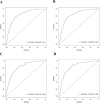Development and validation of a nomogram for predicting cancer-specific survival in small-bowel adenocarcinoma patients using the SEER database
- PMID: 38849854
- PMCID: PMC11157798
- DOI: 10.1186/s12957-024-03438-x
Development and validation of a nomogram for predicting cancer-specific survival in small-bowel adenocarcinoma patients using the SEER database
Abstract
Background: Small bowel adenocarcinoma (SBA) is a rare gastrointestinal malignancy forwhich survival is hampered by late diagnosis, complex responses to treatment, and poor prognosis. Accurate prognostic tools are crucial for optimizing treatment strategies and improving patient outcomes. This study aimed to develop and validate a nomogram based on the Surveillance, Epidemiology, and End Results (SEER) database to predict cancer-specific survival (CSS) in patients with SBA and compare it to traditional American Joint Committee on Cancer (AJCC) staging.
Methods: We analyzed data from 2,064 patients diagnosed with SBA between 2010 and 2020 from the SEER database. Patients were randomly assigned to training and validation cohorts (7:3 ratio). Kaplan‒Meier survival analysis, Cox multivariate regression, and nomograms were constructed for analysis of 3-year and 5-year CSS. The performance of the nomograms was evaluated using Harrell's concordance index (C-index), the area under the receiver operating characteristic (ROC) curve, calibration curves, decision curve analysis (DCA), net reclassification improvement (NRI), and integrated discrimination improvement (IDI).
Results: Multivariate Cox regression identified sex, age at diagnosis, marital status, tumor site, pathological grade, T stage, N stage, M stage, surgery, retrieval of regional lymph nodes (RORLN), and chemotherapy as independent covariates associated with CSS. In both the training and validation cohorts, the developed nomograms demonstrated superior performance to that of the AJCC staging system, with C-indices of 0.764 and 0.759, respectively. The area under the curve (AUC) values obtained by ROC analysis for 3-year and 5-year CSS prediction significantly surpassed those of the AJCC model. The nomograms were validated using calibration and decision curves, confirming their clinical utility and superior predictive accuracy. The NRI and IDI indicated the enhanced predictive capability of the nomogram model.
Conclusion: The SEER-based nomogram offers a significantly superior ability to predict CSS in SBA patients, supporting its potential application in clinical decision-making and personalized approaches to managing SBA to improve survival outcomes.
Keywords: Cancer-specific survival; Neoplasm staging; Nomogram; SEER database; Small bowel adenocarcinoma.
© 2024. The Author(s).
Conflict of interest statement
The authors declare that the research was conducted without any commercial or financial relationships that could be seen as potential conflicts of interest.
Figures








Similar articles
-
A convenient clinical nomogram for predicting the cancer-specific survival of individual patients with small-intestine adenocarcinoma.BMC Cancer. 2020 Jun 1;20(1):505. doi: 10.1186/s12885-020-06971-6. BMC Cancer. 2020. PMID: 32487033 Free PMC article.
-
A nomogram for predicting cancer-specific survival in patients with locally advanced unresectable esophageal cancer: development and validation study.Front Immunol. 2025 Feb 14;16:1524439. doi: 10.3389/fimmu.2025.1524439. eCollection 2025. Front Immunol. 2025. PMID: 40028339 Free PMC article.
-
Nomograms predict survival of patients with small bowel adenocarcinoma: a SEER-based study.Int J Clin Oncol. 2021 Feb;26(2):387-398. doi: 10.1007/s10147-020-01813-8. Epub 2020 Oct 28. Int J Clin Oncol. 2021. PMID: 33113018
-
A nomogram for predicting the risk of liver metastasis in non-functional neuroendocrine neoplasms: A population-based study.Eur J Surg Oncol. 2025 May;51(5):109708. doi: 10.1016/j.ejso.2025.109708. Epub 2025 Feb 21. Eur J Surg Oncol. 2025. PMID: 40024114 Review.
-
Prognostic nomograms for young breast cancer: A retrospective study based on the SEER and METABRIC databases.Cancer Innov. 2024 Oct 25;3(6):e152. doi: 10.1002/cai2.152. eCollection 2024 Dec. Cancer Innov. 2024. PMID: 39464427 Free PMC article. Review.
Cited by
-
A Holistic Approach to Implementing Artificial Intelligence in Lung Cancer.Indian J Surg Oncol. 2025 Feb;16(1):257-278. doi: 10.1007/s13193-024-02079-6. Epub 2024 Sep 5. Indian J Surg Oncol. 2025. PMID: 40114896 Review.
-
Intestinal obstruction caused by early stage primary ileum adenocarcinoma: A case report and review of literature.World J Gastrointest Oncol. 2025 Apr 15;17(4):104919. doi: 10.4251/wjgo.v17.i4.104919. World J Gastrointest Oncol. 2025. PMID: 40235870 Free PMC article.
References
Publication types
MeSH terms
Grants and funding
LinkOut - more resources
Full Text Sources

